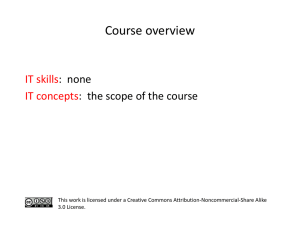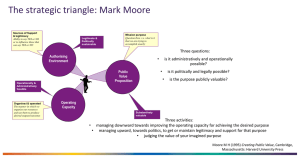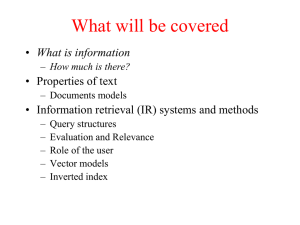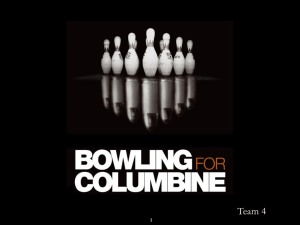Moore
advertisement
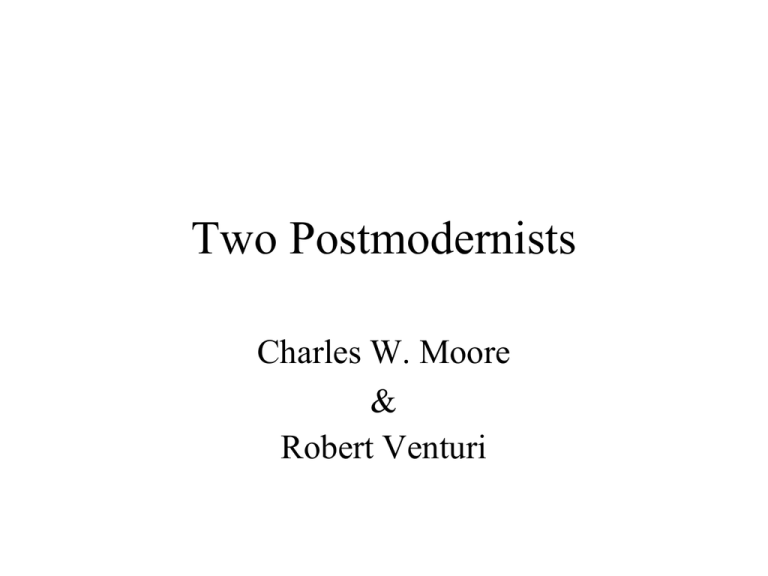
Two Postmodernists Charles W. Moore & Robert Venturi Moore & Venturi • • • • • • Both Postmodernists Contemporary In the Gray Group (Historic Oriented) Educators Published Theorists Practicing Architects Postmodern Architect Charles W. Moore Charles W. Moore (1925-1993) • Background • Written Works • Selected Design Works Charles Willard Moore (1925-1993) • • • • Architect Theorist and Author Educator Received many awards for Contribution and Building Design Bibliography • 1947: graduated from the University of Michigan with a degree in architecture • Worked in San Francisco, served two years in the Army Corps of Engineers • Received Master’s Degree and a Ph.D in architectural history from Princeton University • Taught at Princeton, University of California at Berkeley, Yale, University of California Los Angeles and University of Texas, Austin • Practiced architecture under the firm identification "MLTW" – Moore, Lyndon, Turnbull, Whitaker; Centerbrook; Urban Innovations Group; Moore, Ruble, Yudell; Moore/Anderson Architects Moore’s Books 12 Co-authored Books including: • (1974) The Place of Houses (with Gerald Allen and Donlyn Lyndon) • (1976) Dimensions. Space, Shape and Scale in Architecture (with Gerald Allen) • (1977) Body, Memory and Architecture (with Kent C. Bloomer) • (1988) The Poetics of Gardens (with William J. Mitchell and William Turnbull, Jr.) • (1994) Chambers for a Memory Palace (with Donlyn Lyndon) • You Have to Pay for the Public Life: Selected Essays of Charles W. Moore (2001) Moore’s Roles and Interests • • • • • • Post-Modernist Architect (one of the Gray) Knowledgeable in Architectural History Inclusive Design (like Venturi) Public Life and Public Spaces Pop Architecture (reject pure Modern) Prefers Wonder and Excitement of Everyday Environments “Santa Barbara” in The Place of Houses (1974) • Sense of place – Relaxed air of Mediterranean dream – The common imagery give a sense of “being in the same place” • The application and preservation of Mediterranean style architecture Santa Barbara Santa Barbara as a Unique Place • Relationships between people and enclosures (white stucco walls, tile roofs, iron grills, arcades, columns, balconies, hedges, trees and mountain) • Public realm to live in as much as the private • Encouraging and dramatizing the act of public habitation a stage for daily action • So much cares and agreements were spent on it • Physical embodiment of the shared dream Body Memory and Architecture (1977) • Introductory lecture on basic problem in architecture • About how buildings are experienced before [more than] how they are built • Anthropological conception of architecture • Architecture is measured by the way it is experienced by the human body in space • Basic elements as objects of human perception– space, site, walls, roof, etc., especially orders Body Memory and Architecture (1977) • Architecture as the projection of human experience (house or city) • Architecture is physical and psychological, possession of place by inhabitant who confirms his own identity in the symbols of individual and historic memory (สถาปัตยกรรมเป็ นการยึดครองสถานที่ทาง กายภาพและทางจิตวิทยาของผูอ้ ยู่ ที่ได้ยนื ยันอัตลักษณ์ของตนเอง ด้วยสัญลักษณ์ส่วนตัว และความทรงจาต่อประวัติศาสตร์) Problems with Modernism • Architectural beliefs became severely “rational” • Architecture as a highly specialized system with a set of prescribed technical goals rather than a sensual social art responsive to real human desires and feeling • Relied more on 2D diagram and quantifiable features than colorful 3D qualities of the whole architectural experience • Cartesian notion of space and measurement • Human body has not been a central concern in the understanding of architectural form Moore’s Intentions • Re-examine the significance of the human body in architecture • Examine some post-Cartesian philosophical and psychological thoughts as they pertain to changing views of architecture • Review some models of perception that have been influential in the 20th century • Discuss vocabulary of architectural forms and their relationships Beyond the Body Boundary • We used to measure and order the world out from our own bodies (we don’t anymore) • Cartesian spatial relationship of thing and coordinates (x, y, z) • No connection with the body-centered, value charged sense of space • Except single-family house Cartesian Coordinates and Order Single Family House • Free standing • Based on our sense of ourselves extended beyond the boundaries of our bodies to the world around • With a face and a back– up and down • With a hearth (a heart) • Looks like face (door like a mouth, windows like eyes, a roof like forehead) • Detail outside tells a story about the interior • This house façade is not a billboard, a simple sign, but rather the complex intimation of much more within • The lawn as personal envelop or personal space Single Family House The Lawn Extensions from the Body • Basic enclosure (womb) • Toward the public Identity of the Body Body of Christ, Body of Politic Body of the King The Sense of Beauty • Laws and priorities governing our sense of beauty • Aesthetics comes from the Greek aesthetikos = of sense perception • Reason and Thought vs. Sense and Emotion Different Philosophical Standpoints Beauty, Sense and Thought “One must deduce the meaning of buildings, not sense them” (Descartes) “Sensible knowledge is of course inferior to knowledge developed by the mind alone” (Baumgarten) The Aesthetic Feeling Compared with Measurement • Mechanical measurement (actual bigness) • Visual measurement (the bigness it appears to have) • Bodily measurement (the feeling of bigness) • Only the last has aesthetic value Sense Perception • Five Basic Senses as Perceptual Systems, aggressively seeking information (J. J. Gibson) – – – – – Visual system Auditory system Taste-smell system Basic-orienting system Haptic system • The last two contribute the most to our understanding of 3Ds and architectural experience The Sense of Dwelling • We do not aggressively seek architectural form • We experience satisfaction in architecture by desiring it and dwelling in it, not seeking it • We require a measure of possession and surrounding to feel the impact and the beauty of a building The Sense of Dwelling Body-Image Theory • We have unconscious and changing images of our bodies (separate from our knowledge) • We unconsciously locate our bodies inside a 3dimensional boundary (changing according to internal and external events and strength) • The body boundary can be modified by clothes, badges, weapons, an automobile or an airplane that connect directly to the body and is subject to body-reflex actions Body Movement • The Spatiality of Movement – Awareness of gravity and maintenance of a center – Directions (up, down, left, right) • The Building as a Stimulus for Movement – Architecture functions as a potential stimulus for movement, real or imagined • The Building as a Stage for Movement – Awareness of our own movements in relation to the boundaries as well as our spatial relationship to one another The Stage for Movement The Stage for Movement Vocabulary of Architectural Forms The inhabited world within boundaries that can be identify as a syntax of: • Place: distinguishable from the world around them • Path: limited variety, going one point to another or returning to the same point again • Pattern: composed mostly with paths and places (with recognizable system as bounded space) • Edge: the end of domain with walls, façades, parapets, walls, face out, and the fold in the system or face out from it Place Path Pattern Edge Human Identity in Memorable Places • What missing from our dwellings are the potential transactions between body, imagination and environment • We will care increasingly for our buildings if: – – – – There is some meaningful order in them There is definite boundaries to contain our concerns We can inhabit them We can establish connection with what we know, believe and think – We can share with others – Some sense of human drama, of transport, of tension, or of collision of forces The Real [memorable] Place They are memorable because • They are unique • They affect our bodies and generate enough associations to hold it in our personal worlds • They are susceptible to continuous readings– complex and ambiguous ones • Changeability Moore’s Preferences and Styles • • • • • Neo-Vernacular Historic References Pseudo Public Space and Historic Elements Movements Analogy of Water (flexible arrangement– out of, go in pass through, up and down, etc.) • Dramatic Experiences/ Choreographic Work Examples of Architectural Design: Moore and Others Moore House (1962) "Its forms admittedly derive from primitive huts and from Mayan or Hindu temples…and Moore makes it clear that he was thinking in broad and recollective terms when he made the design." Gerald Allen Sea Ranch Condominium (1965) California Kresge College, University of California (1973) • Promote feeling of community • Shopping mall concept • Paths • Bodies moving through planes or stage • Trivial monuments Kresge College (1973) Burns House (1974) California "The Burns House was designed for an urban planner...and he brought at least two specific requirements to it. The building should reflect the patterns and traditions of life in southern California, and it also had to house a fine baroque pipe organ... The result is a series of sheds and towers,… but here clothed in more regionally apposite stucco in many shades of ochre, orange, and mauve…” Gerald Allen Burns House (1974) Piazza d’Italia (1977) New Orleans Hood Museum of Art (1983) New Hampshire Hood Museum of Art Beverly Hills Civic Center (1988-90) California Urban architecture, which enriches public life Old City Hall from 1939 Beverly Hills Civic Center Plaza Beverly Hills Civic Center Movements Beverly Hills Civic Center Details Afterwards • There are no schemes for multifamily housing or largescale urban reconstruction that satisfy all the senses of the body and nurture the memory as well • The design of the environment is a choreography of the familiar and the surprising, in which the familiar has the central role, and a major function of the surprising is to render the familiar afresh Comparison: Venturi and Moore (both apply historic elements—the grey) Venturi • Emphasize message • Symbol in the environment • View from outside • Ambiguity • More superficial • Use historic elements unconventionally Moore • Emphasize body sense • Body experience extended • View (feel) from within • Dramatic • More philosophical • Use unconventional elements to achieve historic memory Architecture as… Venturi: Symbol Moore: Experience

